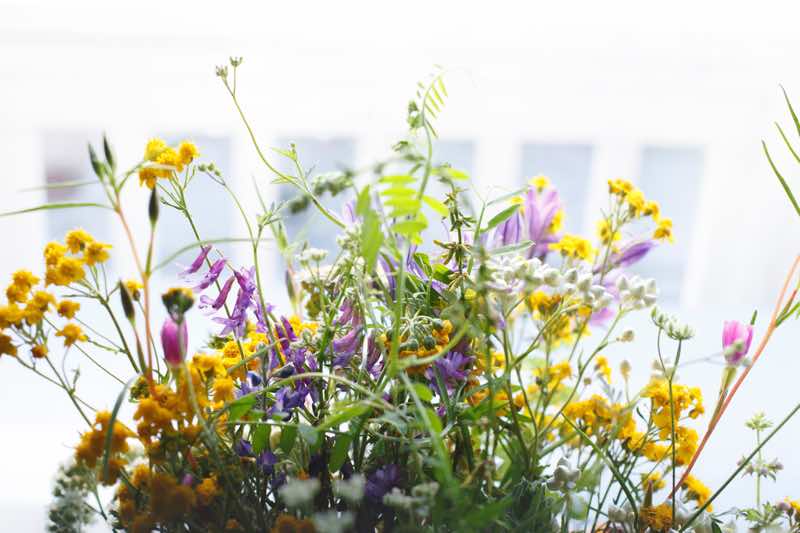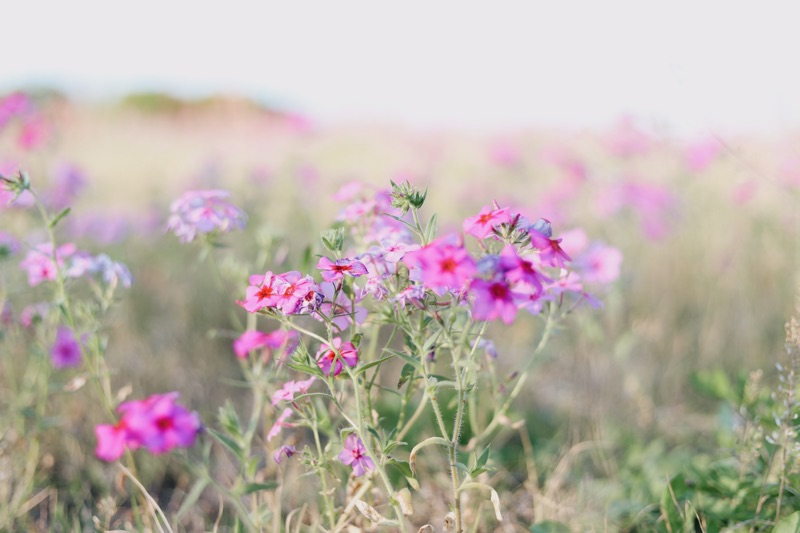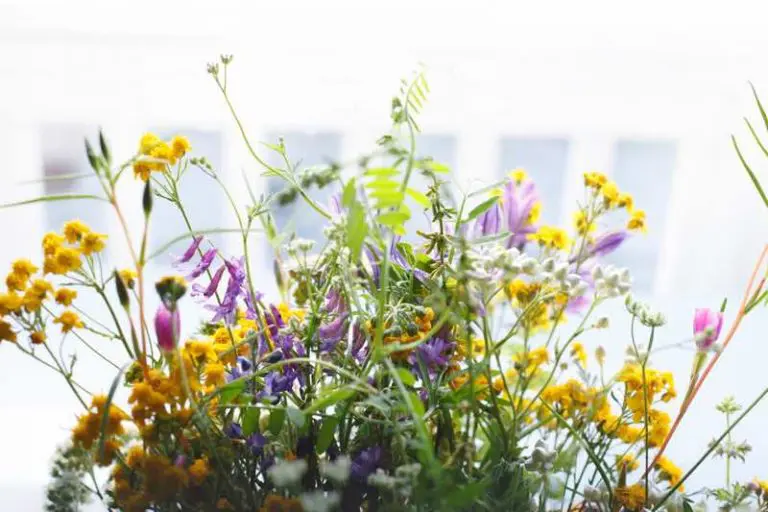Wildflowers are an excellent choice for anyone looking to add beauty, color, and a touch of nature to their garden. They’re incredibly easy to grow, don’t require much attention, and come in a stunning range of colors, textures, and even flavors! Plus, many wildflowers are edible, adding even more reason to grow them. Here’s a simple guide to help you grow wildflowers in your garden, including tips on planting, care, and some edible varieties you can enjoy.

What Are Wildflowers?
Wildflowers are plants that grow naturally in the wild without any help from humans. They’re found in various climates and geographical regions, and they tend to thrive on their own. There are two main types of wildflowers:
- Cornfield Annuals – These are flowers like the Field Poppy, Cornflower, and Corn Marigold. They only last one year but create a vibrant display during their brief lifespan.
- Perennial Wildflowers – These flowers come back year after year. They’re a bit easier to grow since they establish themselves in the ground, but they may not be as flashy as annuals. Still, perennials, like Yarrow, make a lovely backdrop in your garden.
How to Grow Wildflowers

Growing wildflowers in your garden is incredibly easy, especially since they’re native to your area and adapted to local conditions. Here’s a step-by-step guide to get you started:
1. Find a Sunny Spot
Wildflowers thrive in sunny areas, as they naturally grow in open fields. Aim for a spot that gets 5–6 hours of sunlight daily. If possible, plant them away from shadows and towards the center of your garden for the best light.
2. Choose the Right Wildflowers
Pick wildflowers that are native to your region. These are the best suited to your climate and soil, and they’ll thrive without needing extra care. If you’re growing edible wildflowers, make sure to choose organic, non-GMO seeds to ensure you’re getting the highest quality.
3. When to Plant
:max_bytes(150000):strip_icc()/ms-what-to-plant-when-5e28cc19d4094cdc8f4fceab5ea9095b.jpg)
The ideal time to plant wildflowers is in early spring or late fall. This gives the seeds time to settle before the frost hits. Some flowers can be planted year-round, but check the specific growing instructions for each one.
4. Prepare the Soil
Clear the planting area of weeds and grass using a rake, hoe, or shovel. If you have a larger garden, you may want to use a tiller to loosen the soil, which will help your seeds take root.
5. Plant the Seeds
:max_bytes(150000):strip_icc()/how-to-direct-sow-garden-seeds-2539874-hero-32074607f4f94af9a5260980f98280c6.jpg)
You can plant wildflowers individually or in a mix for a more natural look. Follow the instructions on your seed packet for planting depth and spacing. If you’re using seed balls, all you need to do is water them and place them in a sunny spot.
6. Water Regularly
Wildflowers need plenty of moisture to grow. Keep the soil moist until you see the seeds germinate (usually when they’ve reached 4-6 inches tall). After that, you can cut back on watering and only water once or twice a week, depending on the weather.
Wildflower Care
Once your wildflowers are growing, they’re low-maintenance and won’t require much attention. Here are some simple care tips:
- Water as Needed: Wildflowers are drought-tolerant but will need more water during dry spells. Keep the soil consistently moist, especially when they’re young.
- Weeding: Wildflowers naturally grow in dense patches, so weeds won’t be much of an issue. Just remove any that pop up occasionally.
- Mowing: At the end of the season, mow your garden to about 6 inches tall. This will help the plants stay tidy and encourage the annuals to reseed themselves.
Edible Wildflowers You Can Grow
:max_bytes(150000):strip_icc()/EdibleFlowers01-b82a8ce14add4b1fa7815c45bf90a4e7.jpg)
Not only do wildflowers make your garden beautiful, but many of them are also edible! You can use them in teas, salads, or even baking. Here are some delicious edible wildflowers to consider:
- Borage: Known for its star-shaped blue flowers, borage has a cucumber-like taste. Add it to salads or even drinks like lemonade or gin & tonic for a refreshing twist.
- Chicory: Chicory has delicate blue flowers that are perfect for garnishing salads. It has a slightly bitter flavor, making it an interesting addition to savory dishes.
- Hedge Garlic: With small white flowers that taste like garlic with a hint of mustard, hedge garlic is a great addition to your kitchen. Toss them in salads or use them as a garnish.
- Wild Marjoram: This herb grows clusters of pastel pink blossoms and has a strong oregano-like flavor. Use it in place of regular oregano in recipes.
- Wild Onion: These wildflowers look like orchids but belong to the onion family. They have a strong onion flavor, which can be mellowed out by cooking.
- Evening Primrose: The flowers of this plant are sweet when fresh and taste like caramel when baked. You can also use the seeds, just like poppy seeds, in baking.
Wildflower Garden FAQs
1. What are the best wildflowers for beginners?
For beginners, it’s best to choose hardy and low-maintenance wildflowers that are well-suited to your climate. Some good options include:
- Black-eyed Susan (Rudbeckia)
- Cornflower (Centaurea)
- Shasta Daisy (Leucanthemum)
- Poppies (Papaver)
- California Poppy (Eschscholzia californica)
These flowers are easy to grow, drought-tolerant, and provide beautiful color throughout the growing season.
2. Do wildflowers require a lot of sunlight?
Most wildflowers thrive in full sunlight. They typically need at least 6 hours of direct sunlight each day to grow strong and bloom abundantly. Some wildflower varieties, like certain types of violets and foxglove, can tolerate partial shade, but for the best results, plant them in a sunny spot.
3. Can wildflowers be grown in containers or pots?
Yes, wildflowers can be successfully grown in containers or pots, especially if you’re limited on space. Use a well-draining potting mix and ensure the container has drainage holes. You can plant a variety of wildflowers in containers, but it’s important to choose plants that are compatible with container growth and will not become overcrowded.
4. How do I prepare the soil for planting wildflowers?
Before planting wildflowers, it’s important to prepare the soil properly:
- Clear the area of weeds, rocks, and other debris.
- Loosen the soil with a rake or garden fork to ensure good seed-to-soil contact.
- Mix in some compost or organic matter if the soil is heavy or poor in nutrients.
- Wildflowers generally prefer slightly sandy or loamy soil, so avoid overly rich or clay-heavy soil.
5. When is the best time to plant wildflowers?
The best time to plant wildflowers depends on the climate in your region:
- Spring: For most wildflowers, early spring (after the last frost) is an ideal time to plant.
- Fall: Some wildflowers can be planted in the fall as well. This allows them to overwinter and establish roots before spring growth.
Check local planting guides for more specific recommendations based on your region.
6. How often should I water my wildflowers?
Wildflowers are generally drought-tolerant and don’t need to be watered frequently once established. However, when you first plant the seeds or young plants, keep the soil moist until they germinate. After that, water deeply but infrequently. Most wildflowers only need watering during extended dry periods.
7. Do wildflowers need to be fertilized?
Wildflowers typically don’t require much fertilization. In fact, too much fertilizer can encourage the growth of foliage at the expense of flowers. If your soil is poor, you can add compost or organic matter at planting time, but avoid over-fertilizing. Wildflowers thrive in nutrient-poor soils and tend to perform best with minimal intervention.
8. How do I manage weeds in a wildflower garden?
Weeds can compete with wildflowers for nutrients and space. To manage them:
- Mulch the area to suppress weed growth.
- Hand-pull weeds regularly, especially before they flower and set seed.
- Avoid using herbicides, as they can harm your wildflowers. Instead, use organic mulch or use weed barrier fabric where necessary.
9. Can I mix different types of wildflowers in the same garden?
Yes, you can mix different types of wildflowers in the same garden. A variety of wildflowers can create a colorful and diverse garden. However, it’s important to choose species that have similar growing requirements (e.g., light, soil, water) and complement each other in terms of height and bloom time. Be sure to space them appropriately to allow room for growth.
10. Can I use wildflowers in cooking?
Yes! Many wildflowers are edible and can be used to enhance your cooking. Some edible wildflowers include:
- Nasturtiums: Peppery flavor, great for salads.
- Pansies: Mild flavor, perfect as a garnish.
- Calendula: Can be used in soups or as a natural dye.
- Chives: Edible flowers with a mild onion flavor.
Before consuming wildflowers, make sure they are safe to eat, and be sure to avoid any that have been treated with pesticides.
11. How do I encourage wildflower reseeding?
Many wildflowers are self-seeding, meaning they will naturally drop seeds that grow into new plants the following season. To encourage reseeding:
- Allow the flowers to go to seed and dry on the plant before cutting them back.
- If needed, scatter the seeds in late fall or early spring to give them the best chance of germinating.
12. Do wildflowers attract pollinators?
Yes, wildflowers are excellent for attracting pollinators like bees, butterflies, and hummingbirds. By planting a variety of wildflowers with different bloom times, you can create a continuous food source for pollinators throughout the season.
Conclusion
Growing wildflowers is a simple and rewarding way to add beauty, color, and even flavor to your garden. They’re easy to grow, require minimal care, and can even be used in your cooking. Whether you choose annuals or perennials, there’s a wildflower variety to suit every garden. So, why not start your own wildflower garden today and enjoy the natural beauty they bring to your outdoor space!

